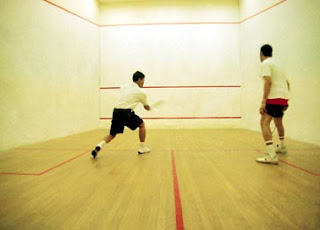Squash is a racquet sport played by two players in a four-walled court with a small, hollow rubber ball. Squash is recognized by the IOC and remains in contention for incorporation in a future Olympic program.
The game was formerly called squash racquets, a reference to the "squashable" soft ball used in the game (compared with the fatter ball used in its parent game rackets.
Court
The 'softball' or 'international' court size was codified in London, England in the late 1920s, at 9.75 m long and 6.4 m wide. The front wall was provided with an "out line" 4.57 m above the floor, connected by a raking "out" line meeting the "out" line on the back wall at 2.13 m above the floor. The front wall also has a "service line" ,originally called the cut line, 1.83 m above the floor with a 19-inch-high "tin" acting as a 'net' (originally sheeted with metal in order to make a distinctive sound when hit by the ball). The floor is marked with a transverse "half-court" line and further divided into two rear "quarter courts" and two "service boxes", as shown in the diagram above.
The traditional "American" court for the U.S. game, is a similar size, but narrower at 5.64 m. The floor and wall markings differ slightly from the "International" court and the tin is lower, at 38 cm high. However, hardball squash was replaced by softball in America as the standard version of squash and has since almost completely died off.
A "Converted Court" is the result of converting racquetball courts to squash. Racquetball courts are 6.1 m wide and 12.2 m in length, so it is relatively easy to install a back wall, producing a squash court of 6.1 m wide by 9.75 m long.
Racquets
Old and new styled Squash racquets
Ball
Different balls are provided for varying temperature and atmospheric conditions and standards of play. More experienced players use slow balls that have less bounce than those used by less experienced players. Depending on its specific rubber composition, a squash ball has the property that it bounces more at higher temperatures. Small coloured dots on the ball indicate its dynamic level, and thus the standard of play for which it is suited.
Types of shots played
There are many types of shots played that lead to interesting games and strategy.
- Straight drive or 'rail': The ball is hit parallel and close to a side wall to travel deep to the back of the court (the 'basic' squash shot). Often referred to as a 'good length' shot.
- Boast (or angle): The ball is played off a side wall at an angle, or the back wall, before hitting the front wall.
- Volley: The ball is hit 'on the full' (before it touches the floor), usually directly to the front wall
- Drop shot: The ball is hit gently against the front wall, to fall softly to the floor in the front corner.
- Lob: The ball is hit softly and high on the front wall and with a high arc, so that it falls in a back corner of the court.
- Cross Court: The ball is hit to the front wall from the right side to the left (or vice versa).
- Kill: The ball is hit hard and low on the front wall so that it travels no farther than half court.
- Trickle boast: A 'short' boast where the ball is hit to the side wall at the front of the court (often disguised as a drive or drop shot).
- Squeeze boast: A more difficult shot which is hit from the front of the court when the ball is very close to the side wall. Has the same effect as the trickle boast but is more deceptive because of its difficulty.
- Skid boast: The ball is hit high to the side wall near the front wall so that it travels cross court and falls in the opposite back corner.
- Nick shot: the ball is 'volleyed' or hit off a bounce, cross court and with power to strike the front wall then the junction of the side wall and floor (the 'nick'). When hit well, the ball will have little or no bounce or roll along the floor (this is a more advanced shot that is a variation of the kill shot).
- Back wall shot: the ball is hit moderately hard and high off the back wall, so that it goes the length of the room and hits (usually low) off the front wall.
Player and records
Dato' Nicol David
She has been many times of the champion in many competition.
She is currently ranked the number one female squash player in the word.














